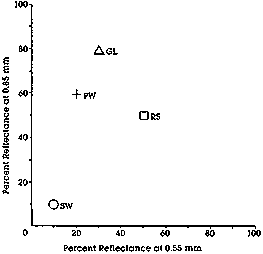Thus, at some wavelengths, sand may reflect more light than green vegetation but at other wavelengths it absorbs more light (thus, reduced reflection) than does the now more reflective vegetation. In principle, various kinds of surface materials can be recognized and distinguished from each other by these differences in relative reflectances, provided there is some suitable method for measuring these differences as a function both of wavelength and of intensity of returned radiation (as a fraction or percent of the amount of the irradiating radiation) To exemplify how the four common surface materials (GL = grasslands; PW = pinewoods; RS = red sand; SW = silty water) shown in the next figure can be characterized as distinct, note the positions of points for each plotted as percent reflectances for just two wavelengths in the figure below.

When more than two wavelengths are involved, the plots in multi-dimensional space tend to increase the separability among different materials; this is the basis for multispectral remote sensing (discussed below).
Code 935, Goddard Space Flight Center, NASA
Written by: Nicholas M. Short, Sr. email: nmshort@epix.net
and
Jon Robinson email: Jon.W.Robinson.1@gsfc.nasa.gov
Webmaster: Bill Dickinson Jr. email: rstwebmaster@gsti.com
Web Production: Christiane Robinson, Terri Ho and Nannette Fekete
Updated: 1999.03.15.